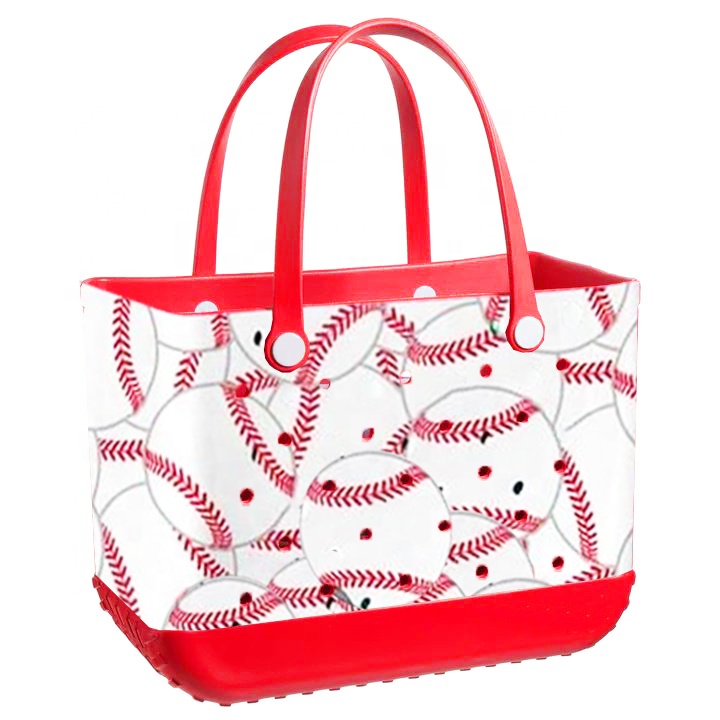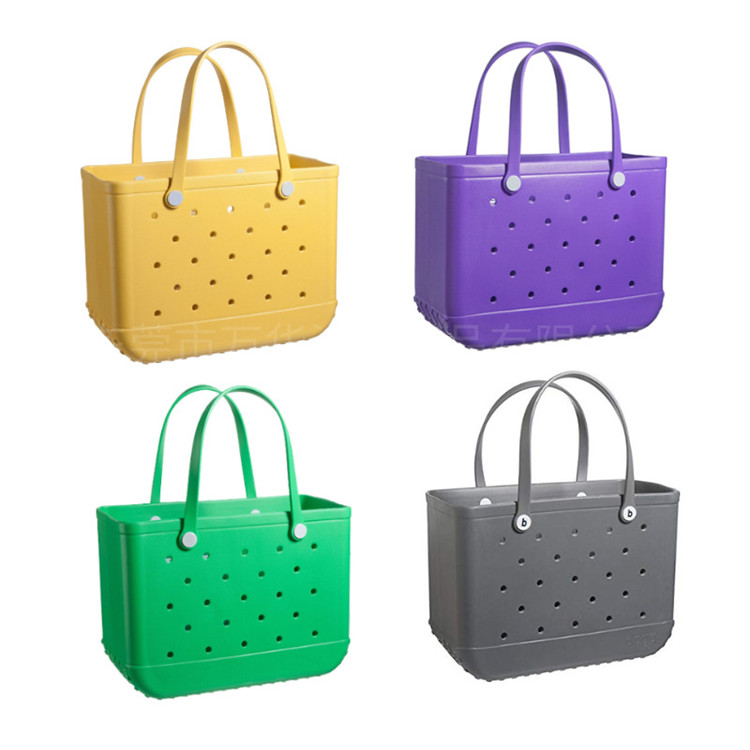Introduction
When you hit the beach, take a dip in the pool, or head out for a camping trip, the EVA beach bag often accompanies you as an indispensable accessory. Its distinctive look catches the eye, but its real charm lies in its remarkable functionality. The EVA beach bag not only holds all your essentials but does so with an ingenious design that keeps sand out and lets water flow freely.
Ever wondered what makes this seemingly simple bag so effective? How does the mesh design manage to keep sand at bay while allowing seawater and other liquids to drain out effortlessly? The answer lies in the clever interplay of mesh size, shape, and material. In the following sections, we’ll dive into the science behind EVA beach bag’s design, uncovering how physics and engineering come together to create a bag that’s both practical and fascinating.
Design Features of the EVA beach bag
Mesh DesignThe mesh design of the EVA beach tote is one of its standout features, both visually unique and highly functional. The mesh holes are carefully sized and arranged to optimize performance:
Hole Size: The mesh openings typically range from 2 to 4 millimeters in diameter. This size is chosen to effectively block most sand particles, which generally range from 0.1 to 2 millimeters in diameter, while allowing water to flow through quickly.
Hole Shape: The mesh usually features uniformly spaced, round holes. This shape ensures even distribution of pressure and prevents localized water accumulation, enhancing fluid drainage.
Hole Arrangement: The mesh is arranged in a grid pattern, which provides uniform spacing between holes. This design helps in blocking larger particles while promoting efficient water drainage.

Screening Principles
Basic Screening PrinciplesScreening is a fundamental technique used in various industries to separate different-sized particles from a mixture. The core principle of screening relies on the size and shape of the openings in a mesh or sieve. Here’s a breakdown of how it works:
Separation Mechanism: Screening involves passing a mixture through a mesh with openings of a specific size. Particles smaller than the mesh openings pass through, while larger particles are retained. This separation occurs because the mesh allows only particles smaller than its apertures to pass through, effectively sorting materials based on size.
Flow Dynamics: When a mixture is placed on a screen, gravity and vibration (if used) cause the particles to move across the mesh. The smaller particles fall through the openings due to their size and weight, while the larger particles are trapped on top of the mesh.
Mesh Size and Particle Size Relationship
The relationship between mesh size and particle size is crucial for effective screening. The mesh size determines which particles can pass through and which are retained. Here’s how it works in the context of EVA beach bags:
Mesh Size: For EVA beach bags, the mesh openings are typically between 2 to 4 millimeters in diameter. This size is specifically chosen to block sand particles, which usually range from 0.1 to 2 millimeters, while allowing larger particles and liquids to pass through.
Particle Size: Sand particles are generally within the range of 0.1 to 2 millimeters in diameter. EVA beach totes are designed with mesh openings that are slightly larger than the upper limit of typical sand particle sizes. This ensures that while sand is effectively blocked, water, which has much smaller individual droplets, can flow through without obstruction.
Fluid Dynamics Principles
Liquid Flow Through MeshUnderstanding how liquids flow through a mesh involves key principles from fluid dynamics. In the context of EVA beach bags, these principles explain why water, such as seawater, can efficiently flow through the mesh openings while larger particles like sand are retained.
Fluid Flow Basics: When a liquid like seawater comes into contact with a mesh, it flows through the openings due to differences in pressure and fluid properties. Seawater, which is a mixture of water and dissolved salts, has a relatively low viscosity compared to many solid particles. This low viscosity allows the liquid to pass through the mesh more easily.
Capillary Action: While not the primary factor in large mesh openings, capillary action can influence how liquids move through smaller or denser meshes. In the case of EVA beach totes, capillary action helps water spread across the mesh surface and move through the openings more efficiently.
Impact of Hole Size and Shape on Flow
The size and shape of the mesh openings play a significant role in determining how effectively liquids can pass through. For EVA beach bags, the design is optimized to ensure smooth liquid flow while preventing larger particles from entering.
Hole Size: The mesh openings in EVA beach bags are typically between 2 and 4 millimeters in diameter. This size is large enough to allow water, which can be in the form of tiny droplets or small streams, to flow through quickly. For instance, water droplets are significantly smaller than the mesh openings, so they pass through with ease. In contrast, sand particles, which are generally larger than the mesh size, are blocked.
Shape and Arrangement: The mesh holes are usually round and arranged in a regular grid pattern. This shape ensures that the flow of water is not obstructed by sharp edges or irregular shapes. Round holes create a consistent flow path, minimizing turbulence and allowing water to drain efficiently. Irregularly shaped holes might cause partial blockages or uneven flow, which could impede the drainage process.
Practical Applications and Effectiveness
Usage ScenariosThe EVA beach tote is designed to perform exceptionally well in various environments, making it a versatile accessory for outdoor activities. Here are some common scenarios where the EVA beach bag excels:
Beach Trips: At the beach, the EVA beach bag’s mesh design prevents sand from getting inside while allowing water to drain out quickly. This feature keeps the interior clean and dry, making it easy to store beach essentials like towels, sunscreen, and snacks without the hassle of sand getting into every crevice.
Poolside: When used around a pool, the EVA beach bag’s water-resistant EVA material and drainage mesh ensure that any pool water that gets inside the bag can be easily expelled. This keeps the bag’s contents from becoming soggy and prevents the buildup of pool chemicals inside the bag.
Camping: During camping trips, the EVA beach tote’s durability and resistance to various elements make it a reliable choice for carrying gear. The bag can handle rough terrain and keep contents protected from dirt and moisture, making it ideal for storing outdoor equipment and personal items.
Conclusion
In a nutshell, the EVA beach bag is a triumph of clever design, seamlessly blending mesh technology with tough EVA material to keep sand out and water flowing effortlessly. Whether you're lounging at the beach, hanging out poolside, or roughing it on a camping trip, this bag has got you covered—literally. Its smart design solves the pesky problems of sand and sogginess, proving that sometimes, great solutions come from simple, well-thought-out ideas. Who knows? The innovative spirit behind the EVA beach tote might just inspire more game-changing designs in unexpected places, making everyday life a little more convenient and a lot more fun.
 English
English Español
Español Português
Português Pусский
Pусский Français
Français Deutsch
Deutsch 日本語
日本語 한국어
한국어 Italiano
Italiano عربى
عربى